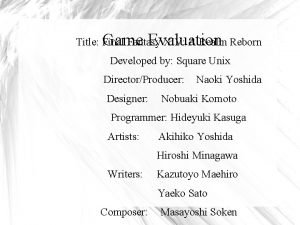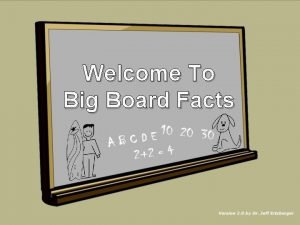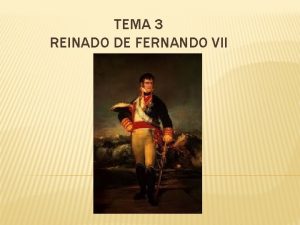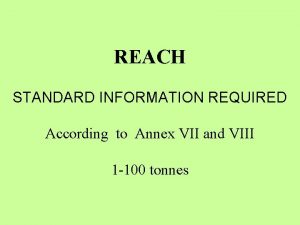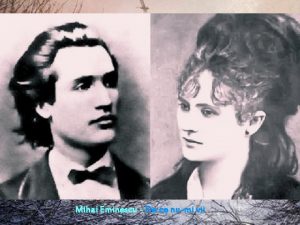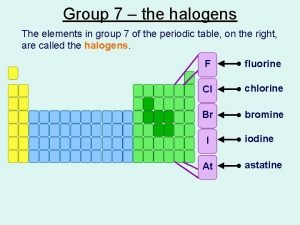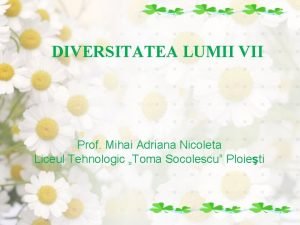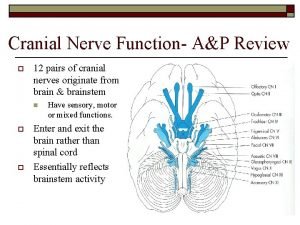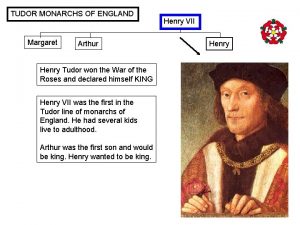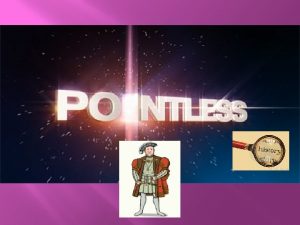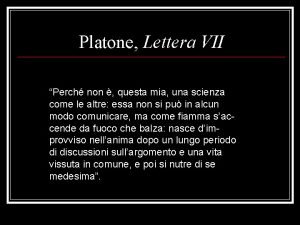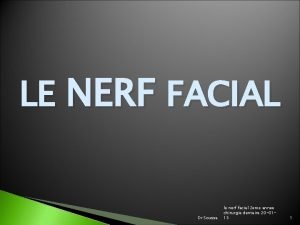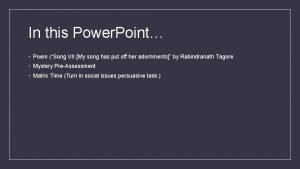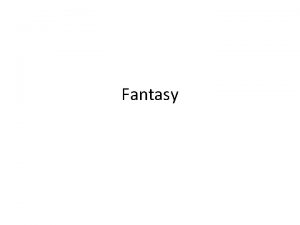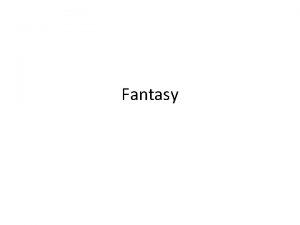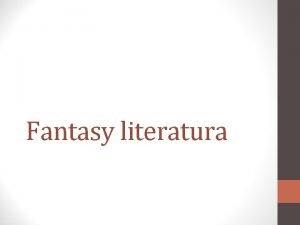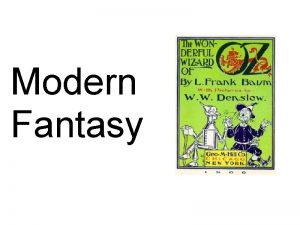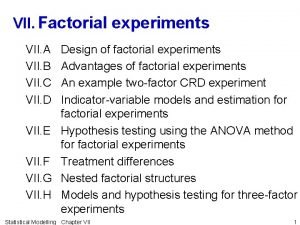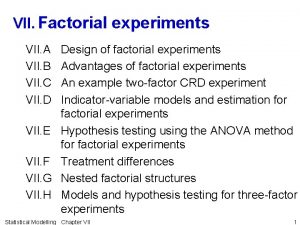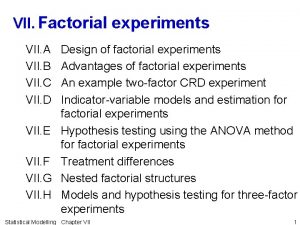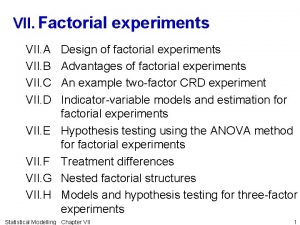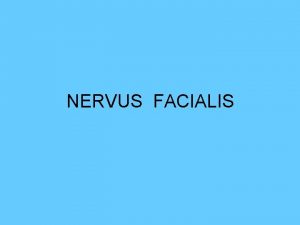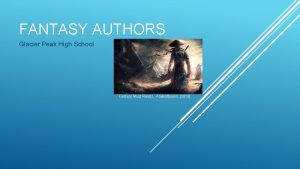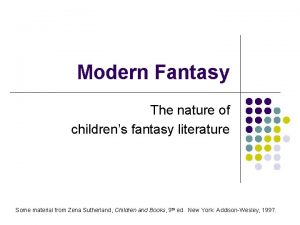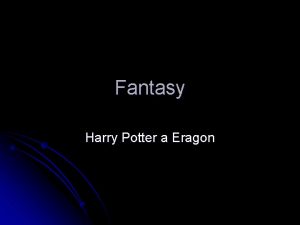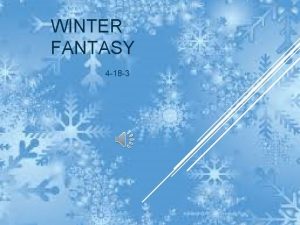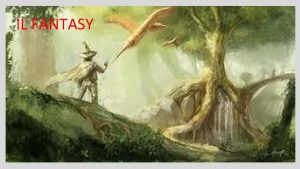FINAL FANTASY VI AND FINAL FANTASY VII Final




















- Slides: 20

FINAL FANTASY VI AND FINAL FANTASY VII

Final Fantasy VII

Quick Specs Final Fantasy 6 (VI) § Released 1994 for the SNES § 2 D world, Distorted 3 D world map (height not accurately represented) § 14 playable characters Story not centered around a single character § High quality soundtrack § First in the series to rely on a theme of hybrid Technology and Magic run amok (A steampunk civilization rediscovers magic with disastrous consequences) § Magic facilitated by ‘Espers’ Final Fantasy 7 (VII) § Released 1997 for the PS § 3 D world and world map § 9 playable characters Story centered on character Cloud Strife § High quality soundtrack § Continues the Technology/Magic theme in an environmental setting (Mako energy is draining the planet of energy/Lifestream) § Magic facilitated by ‘Materia’

A few words about Interactive Narratives § These two Final Fantasy games, while considered to be of the RPG genre are the poster children for the type of games commonly classified as interactive narratives. § Two weeks ago I summarized Michael Mateas’ article about interactive drama and, in the period between, used his ideas to develop a “Poetics of RPGs” (see right) by which I will examine these games Summary of “Poetics of RPGs” § § The RPG should not be limited to a first-person view of character. A third-person view of character(s) is allowed with arguably minor consequences for Murray’s categories of immersion and transformation. Narrative is not only welcomed, it is almost always required to provide clear formal causation from the level of plot in the Aristotelian theory of drama. Murray’s aesthetic categories are very important - the degree of agency is directly related to the authenticity of the role-playing experience: a heightened sense of agency is absolutely crucial to the creation of a great role-playing game. - Immersion and transformation have a direct relationship with agency and are thus important too, albeit to lesser extents. A great RPG must be designed to maintain a heightened sense of agency – caused by a balance between the material and formal constraints of the experience. Such a balance will be effective at communicating dramatic probabilities and possibilities and thus the role-player will better appreciate the experience the author had in mind.

Final Fantasy VI (synopsis) (from ffonline. com) § 1000 years ago, the War of the Magi decimated most of the world's technology and all known magic. Today, technology has made an impressive and remarkable comeback, popping up almost everywhere on the face of civilization. The reigning Empire remains at war with various rebel factions, causing unrest among the related parties. Nonetheless, the world is striving successfully to rebuild itself from the perils of War. § However, the Empire has grown curious and power-hungry for the ancient power known only as "magic". Their leader and a slightly insane general crave this power, and are willing to destroy anything that comes in their way. With the finding of an ancient Esper, a seemingly vital source of "magic", the Empire is poised to take full control of this mysterious power. § Several warriors, from all walks of life, must band together despite their differences in order to save the world from one who would conquer it, and who would destroy it.

Final Fantasy VI (characters) The character party Shadow Terra Locke Edgar Sabin Celes Cyan Gau Setzer Mog The empire Emperor Gestahl Kefka General (Many) 1 st - 3 rd Class Soldiers Leo The Espers (26* total) Strago Umaro Relm Gogo

Final Fantasy VI (gameplay) some videos to illustrate the game Play. Station Intro Desperation/Limit Attacks Esper Exhibition Final Battle - Part 1 original concept art by Amano Yoshitaka (from ffshrine. org)

Final Fantasy VI with regard to the RPG poetic 3 rd person view A third person view is used for many reasons. Of them, technology stands out. The SNES was a 16 -bit system: some of the boss battles pushed the graphics card of the SNES to the limit. Thus a convincing first person view would have been nearly technologically impossible. Square took this constraint in stride, using the 3 rd person view to tell a rich 2 D story of all characters at once. narrative There is no proclaimed/central main character rather, a party of interacting characters. Though each character is of varying importance to the overall story the overlaying narrative accommodates all of the characters, and offers the player the opportunity to explore each character’s back story in more detail and always with beneficial results for the character and party.

Final Fantasy VI with regard to the RPG poetic balancing the constraints from Mateas’ neo-Aristotelian theory Player intentions are constrained from above by authorial formal causation from the level of plot. This is the main storyline (narrative) progressing throughout the game. Player intentions are constrained from below by material resources such as the spectacle/event taking place at the moment, the language available during the spectacle, and the perceived thoughts of the character concerning the spectacle as inferred through pattern and language. (Though this has funny consequences and cliches. ) All of this constraint is used to help the player understand which actions are dramatically probable and thus what actions are worth considering. A heightened sense of agency (feeling of empowerment) within the storyline (versus just the menu systems as mentioned before) is the result of proper constraint balancing.

Final Fantasy VI with regard to the RPG poetic the 3 categories Agency is the most important of Murray’s aesthetic categories for the believability of an RPG experience. Agency is achieved in this game by becoming highly proficient with the menu systems - more than so than through actual gameplay. Remember, agency is the “feeling of empowerment that comes from being able to take actions in a world whose effects relate to the player’s intentions. ” This game is highly narrative, and so the player’s main interaction with the world happens via the menu systems: battle, main menu, shop, etc. The feeling of empowerment, for the majority, comes from better preparing your characters for battle, such as collecting armors, weapons, relics, espers (for magic), and ultimately your own characters! (everyone begins separated in the World of Ruin - halfway through the game) Transformation (as variety) offers a multitude of variations on theme(s). The game has many themes, among them: hope/despair, love/hate, war/peace, trust/betrayal. The player explores these themes through the development of the characters’ back stories and during certain scene responses of each character in certain thematic situations. (The ninja) Shadow’s responses are the most neutral throughout because he “Killed [his] emotions long ago. ” Immersion - the feeling of being present in another place and engaged in the action - is not well represented in this game. This game is very 2 dimensional and very much a videogame heavily relying upon pre-rendered backgrounds both on and off the battlefield - ultimately giving the game an overall noticeable ‘cartooned’ effect. This issue was eventually addressed as a technology constraint, as we will see.

Final Fantasy VII (synopsis) (from ffonline. com) § A giant energy manufacturing company known as Shinra Inc. is harvesting the sheer life energy of the Planet as a simple fossil fuel. Processed and made into products known as Mako and Materia, these materials can work miracles, granting the wisdom of the Ancients to the user. However, this substance, like all other § fuels, is finite in supply, and the Planet's lifeforce is being malevolently drained by the constant exploitation of Mako by Shinra. Though aware of the harmful effects, they function without remorse. § However, the real battle lies not with a corporation, but a force much more competent from the distant past. A longthought dead warrior bent on becoming more and more powerful, coupled with the Planet's drained energy, threatens the very existence of everything sacred. A small rebel group, emanating from the slums, must quell the various dangers toward the innocent, and one mercenary for hire must look amidst the lies and deception and find the man he is within.

Final Fantasy VII (characters) The character party (image material taken from ffonline. com)

Final Fantasy VII (characters) The enemy parties Sephiroth Shinra/The Turks Elena, Tseng, Rufus Shinra, Rude, Reno

Final Fantasy VII (gameplay) some videos to illustrate the game Trailer Dirge of Cerberus Opening Advent Children Final Battle

Final Fantasy VII with regard to the RPG poetic 3 rd person view A third person view is also used extensively throughout this game but for very different reasons. The player is immediately thrust into a 3 D world, and a third person view offers many more possibilities for player to recognize play objects contextually within the environment. It also facilitates smooth transitions between game play and video sequences. In short, a first person view would have been way too limiting to the kind of game Square wanted to make. This is also the reason why, in 1996, Square announced that it would publish Final Fantasy VII with Nintendo’s rival, Sony, for their upcoming Play. Station console The sheer size of the project required 3 CD-Roms and Square needed a way to save that data in one central location. Cartridge games could not do this. narrative The story revolves mainly around the player’s character, Cloud Strife, ex. SOLDIER and mercenary for hire. Each character has a back story that can be developed, but the main game play’s focus is upon Cloud and his past and this theme is extensively covered later on; at one point, the player controls Tifa as she navigate Cloud’s memories, helping him to distinguish the actual truth of his past. When he finally comes to his senses, he re-assumes his leadership role of the party and begins to more consistently act like the leader everyone expects him to be.

Final Fantasy VII with regard to the RPG poetic balancing the constraints from Mateas’ neo-Aristotelian theory Player intentions are constrained from above by authorial formal causation from the level of plot. This is again the main storyline throughout the game which the player must ultimately follow. Player intentions are constrained from below by material resources such as the spectacle/event taking place at the moment, the language available during the spectacle, and the perceived thoughts of the character concerning the spectacle as inferred accordingly (through body language and actual language). This game accomplishes this through the game play, cut scenes, interactive opportunities, and 3 D environment. All of this constraint is used to help the player understand which actions are dramatically probable according to the narrative and thus what actions are worth considering. A heightened sense of agency results. Overall, Final Fantasy VII performs this delicate balancing act very well, relying heavily upon the narrative and 3 D environments to do so.

Final Fantasy VII with regard to the RPG poetic the 3 categories Agency is the “feeling of empowerment that comes from being able to take actions in a world whose effects relate to the player’s intentions” and in this game is realized through mastery of the menu screens like Final Fantasy VI, but also through mini-games and mini-”action” sequences - points in the game where the player must press certain buttons in sequence or according to a careful timing. These scenes are integrated right into the game play and are completely dependent upon the players actions. Transformation (as variety and masquerade) offers a multitude of variations on theme(s) and allows the player to transform themselves for the duration of the game. Transformation as variety refers back to the multiple playable characters in the game and their responses to those themes. The player explores these themes mainly from Cloud’s perspective, or at least what is perceived to be his perspective. Cloud is almost always required to be in the party and when NPCs interact with the party, they mainly interact as if Cloud were alone. This by itself is an instance of transformation as masquerade.

Final Fantasy VII with regard to the RPG poetic the 3 categories (continued) Immersion - the feeling of being present in another place and engaged in the action - is very well represented in this game mainly due to the game being based completely in a pre-rendered 3 D world. Right from the opening sequence, the player is thrown into the action and almost forcefully (but easily) immersed in the experience. The quality of the immersion is first ‘tested’ when the party finally leaves Midgar for the first time (8 hours later) - from the player’s perspective, there is an overall sense of relief at getting out of the mired, urban wasteland that is Midgar and into the wide open, spacious world at large. But the best test for how immersed a player had become, however, was the scene at the end of Disk 1 - where Aeris is killed by Sephiroth. The more immersed the player had become, the more anguish and saddened he/she should have felt over her death, even though it is a part of the narrative. Many were distraught, to say the least.

Compilation of Final Fantasy VII And the Final Fantasy VII saga continues on… “The Compilation of Final Fantasy VII is the formal title for a series of games and animated features developed by Square Enix based in the world and continuity of Final Fantasy VII. Spearheaded by Tetsuya Nomura and Yoshinori Kitase, the series consists of several titles across various platforms, all of which are extensions of the Final Fantasy VII story. The compilation is viewed by Square-Enix as “the company’s first steps toward…’polymorphic content. ’” (Wikipedia) The compilation includes the game Dirge of Cerberus, the movie Advent Children, the mobile game Before Crisis, and a PSP game Crisis Core. (And a couple other videos for both the PSP and Amp’d mobile phones) Before Crisis focuses upon the Turks 6 years before the original game. (1 st in Compilation) Dirge of Cerberus focuses upon Vincent’s story immediately after the meteor crashes into Midgar at the end of the game and then 3 years after that. Noticeably absent from the original game’s final scene are Yuffie and Vincent (because they are sidequest characters. ) Dirge of Cerberus addresses this: they were at ground zero in Midgar helping with the evacuation efforts at the end of the original game. (3 rd in Compliation) Advent Children focuses upon the characters 5 years after the meteor fell, the fallout of the event, and the return of Sephiroth. (2 nd in Compilation) Crisis Core focuses upon Zack’s past. (Released Sept 13, 2007)

Final Fantasy VI and VII Questions? Comments? Want know more? Play the games!
 Hiroshi minagawa
Hiroshi minagawa Prc br435 – code of ethics for professional teachers
Prc br435 – code of ethics for professional teachers Triboron octachloride formula
Triboron octachloride formula Fernando vii
Fernando vii Reach annex vii testing
Reach annex vii testing O vino iar in al meu brat
O vino iar in al meu brat Pedagogika tarixi fanining konseptual asoslari
Pedagogika tarixi fanining konseptual asoslari Group 17
Group 17 Nutritie heterotrofa
Nutritie heterotrofa Cranial nerves smile
Cranial nerves smile Cn viii test
Cn viii test Henryk vii tudor
Henryk vii tudor Animalele se inmultesc prin
Animalele se inmultesc prin Dr margaret henry
Dr margaret henry King henry viii family tree
King henry viii family tree Henry vii
Henry vii Lettera vii platone
Lettera vii platone Nerf vii bis
Nerf vii bis Song vii answer key
Song vii answer key 6/1996. (vii. 16.) müm rendelet
6/1996. (vii. 16.) müm rendelet 10/2015 (vii. 30) hm
10/2015 (vii. 30) hm
